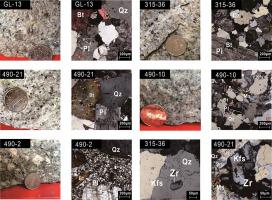Ore Geology Reviews ( IF 3.2 ) Pub Date : 2021-09-01 , DOI: 10.1016/j.oregeorev.2021.104445 Yuzhong Liao 1, 2, 3 , Dehui Zhang 1 , Leonid V. Danyushevsky 4 , Tonglin Li 5 , Yanguang Liu 2, 3

|
The Dongpo ore field, containing a series of W-Sn-Mo-Bi-Pb-Zn granite-related deposits, is a typical reduced intrusion-related system centered with the causative zoned Qianlishan granite complex (QGC). The QGC comprises porphyritic granite, equigranular granite and granite porphyry. According to zircon U-Pb age data, the emplacement timing of the QGC was constrained to 155–151.7 Ma. Here, we conducted a set of geochronological analyses with different closure temperatures (including monazite, apatite U-Pb, biotite and muscovite Ar-Ar and zircon fission track dating) on the QGC, revealing that the QGC experienced a protracted magmatic-hydrothermal timespan of 38.8–53.8 my. The protracted lifespan is probably due to radiogenic heat supplied by highly enriched high-heat-producing elements. The mineralizing blossom time (149–154.2 Ma) in the Dongpo ore field is in accordance with the prolonged lifespan (5.7 my: from 149.3 Ma to 155 Ma) of the magmatic-hydrothermal process caused by the QGC over the temperature range of 300–800 °C. This result implies that successive inputs of magma with high heat-producing elements (U, Th, K) play a fundamental role in the metal enrichment process of intrusion-related deposits and the formation of large economic ore fields.











































 京公网安备 11010802027423号
京公网安备 11010802027423号